Prayag Tiwari
Exploring the correlation between the type of music and the emotions evoked: A study using subjective questionnaires and EEG
Oct 30, 2025Abstract:The subject of this work is to check how different types of music affect human emotions. While listening to music, a subjective survey and brain activity measurements were carried out using an EEG helmet. The aim is to demonstrate the impact of different music genres on emotions. The research involved a diverse group of participants of different gender and musical preferences. This had the effect of capturing a wide range of emotional responses to music. After the experiment, a relationship analysis of the respondents' questionnaires with EEG signals was performed. The analysis revealed connections between emotions and observed brain activity.
Self-Calibrated Consistency can Fight Back for Adversarial Robustness in Vision-Language Models
Oct 26, 2025Abstract:Pre-trained vision-language models (VLMs) such as CLIP have demonstrated strong zero-shot capabilities across diverse domains, yet remain highly vulnerable to adversarial perturbations that disrupt image-text alignment and compromise reliability. Existing defenses typically rely on adversarial fine-tuning with labeled data, limiting their applicability in zero-shot settings. In this work, we identify two key weaknesses of current CLIP adversarial attacks -- lack of semantic guidance and vulnerability to view variations -- collectively termed semantic and viewpoint fragility. To address these challenges, we propose Self-Calibrated Consistency (SCC), an effective test-time defense. SCC consists of two complementary modules: Semantic consistency, which leverages soft pseudo-labels from counterattack warm-up and multi-view predictions to regularize cross-modal alignment and separate the target embedding from confusable negatives; and Spatial consistency, aligning perturbed visual predictions via augmented views to stabilize inference under adversarial perturbations. Together, these modules form a plug-and-play inference strategy. Extensive experiments on 22 benchmarks under diverse attack settings show that SCC consistently improves the zero-shot robustness of CLIP while maintaining accuracy, and can be seamlessly integrated with other VLMs for further gains. These findings highlight the great potential of establishing an adversarially robust paradigm from CLIP, with implications extending to broader vision-language domains such as BioMedCLIP.
Quantum Long Short-term Memory with Differentiable Architecture Search
Aug 20, 2025
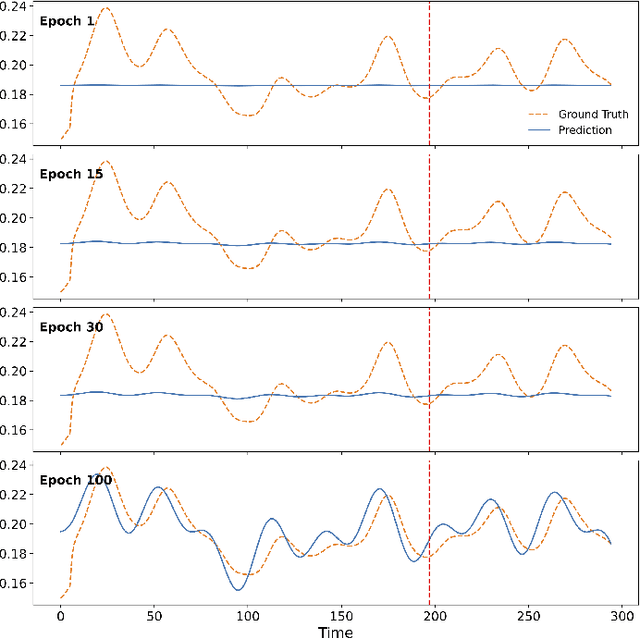
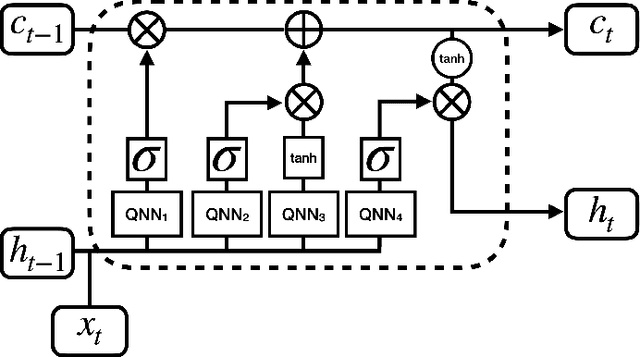
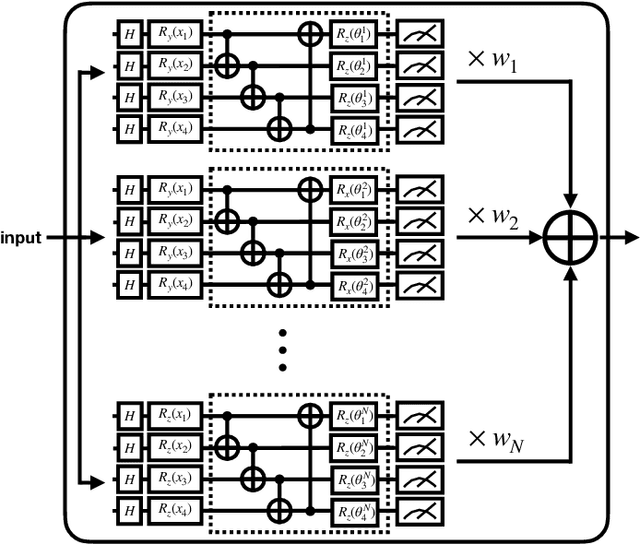
Abstract:Recent advances in quantum computing and machine learning have given rise to quantum machine learning (QML), with growing interest in learning from sequential data. Quantum recurrent models like QLSTM are promising for time-series prediction, NLP, and reinforcement learning. However, designing effective variational quantum circuits (VQCs) remains challenging and often task-specific. To address this, we propose DiffQAS-QLSTM, an end-to-end differentiable framework that optimizes both VQC parameters and architecture selection during training. Our results show that DiffQAS-QLSTM consistently outperforms handcrafted baselines, achieving lower loss across diverse test settings. This approach opens the door to scalable and adaptive quantum sequence learning.
Tensorized Clustered LoRA Merging for Multi-Task Interference
Aug 06, 2025Abstract:Despite the success of the monolithic dense paradigm of large language models (LLMs), the LoRA adapters offer an efficient solution by fine-tuning small task-specific modules and merging them with the base model. However, in multi-task settings, merging LoRA adapters trained on heterogeneous sources frequently causes \textit{task interference}, degrading downstream performance. To address this, we propose a tensorized clustered LoRA (TC-LoRA) library targeting to address the task interference at the \textit{text-level} and \textit{parameter-level}. At the \textit{text-level}, we cluster the training samples in the embedding space to capture input-format similarities, then train a specialized LoRA adapter for each cluster. At the \textit{parameter-level}, we introduce a joint Canonical Polyadic (CP) decomposition that disentangles task-specific and shared factors across LoRA adapters. This joint factorization preserves essential knowledge while reducing cross-task interference. Extensive experiments on out-of-domain zero-shot and skill-composition tasks-including reasoning, question answering, and coding. Compared to strong SVD-based baselines, TC-LoRA achieves +1.4\% accuracy on Phi-3 and +2.3\% on Mistral-7B (+2.3\%), demonstrating the effectiveness of TC-LoRA in LLM adaptation.
NurValues: Real-World Nursing Values Evaluation for Large Language Models in Clinical Context
May 13, 2025Abstract:This work introduces the first benchmark for nursing value alignment, consisting of five core value dimensions distilled from international nursing codes: Altruism, Human Dignity, Integrity, Justice, and Professionalism. The benchmark comprises 1,100 real-world nursing behavior instances collected through a five-month longitudinal field study across three hospitals of varying tiers. These instances are annotated by five clinical nurses and then augmented with LLM-generated counterfactuals with reversed ethic polarity. Each original case is paired with a value-aligned and a value-violating version, resulting in 2,200 labeled instances that constitute the Easy-Level dataset. To increase adversarial complexity, each instance is further transformed into a dialogue-based format that embeds contextual cues and subtle misleading signals, yielding a Hard-Level dataset. We evaluate 23 state-of-the-art (SoTA) LLMs on their alignment with nursing values. Our findings reveal three key insights: (1) DeepSeek-V3 achieves the highest performance on the Easy-Level dataset (94.55), where Claude 3.5 Sonnet outperforms other models on the Hard-Level dataset (89.43), significantly surpassing the medical LLMs; (2) Justice is consistently the most difficult nursing value dimension to evaluate; and (3) in-context learning significantly improves alignment. This work aims to provide a foundation for value-sensitive LLMs development in clinical settings. The dataset and the code are available at https://huggingface.co/datasets/Ben012345/NurValues.
Taylor Series-Inspired Local Structure Fitting Network for Few-shot Point Cloud Semantic Segmentation
Apr 03, 2025Abstract:Few-shot point cloud semantic segmentation aims to accurately segment "unseen" new categories in point cloud scenes using limited labeled data. However, pretraining-based methods not only introduce excessive time overhead but also overlook the local structure representation among irregular point clouds. To address these issues, we propose a pretraining-free local structure fitting network for few-shot point cloud semantic segmentation, named TaylorSeg. Specifically, inspired by Taylor series, we treat the local structure representation of irregular point clouds as a polynomial fitting problem and propose a novel local structure fitting convolution, called TaylorConv. This convolution learns the low-order basic information and high-order refined information of point clouds from explicit encoding of local geometric structures. Then, using TaylorConv as the basic component, we construct two variants of TaylorSeg: a non-parametric TaylorSeg-NN and a parametric TaylorSeg-PN. The former can achieve performance comparable to existing parametric models without pretraining. For the latter, we equip it with an Adaptive Push-Pull (APP) module to mitigate the feature distribution differences between the query set and the support set. Extensive experiments validate the effectiveness of the proposed method. Notably, under the 2-way 1-shot setting, TaylorSeg-PN achieves improvements of +2.28% and +4.37% mIoU on the S3DIS and ScanNet datasets respectively, compared to the previous state-of-the-art methods. Our code is available at https://github.com/changshuowang/TaylorSeg.
FinTeamExperts: Role Specialized MOEs For Financial Analysis
Oct 28, 2024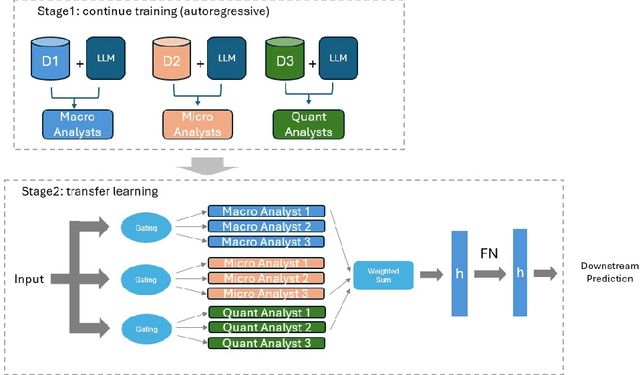
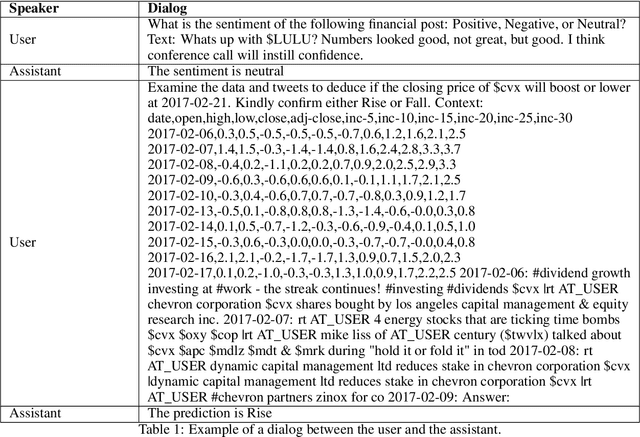
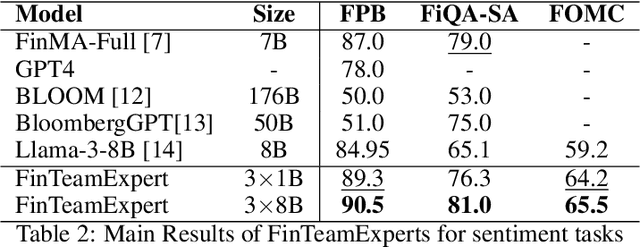
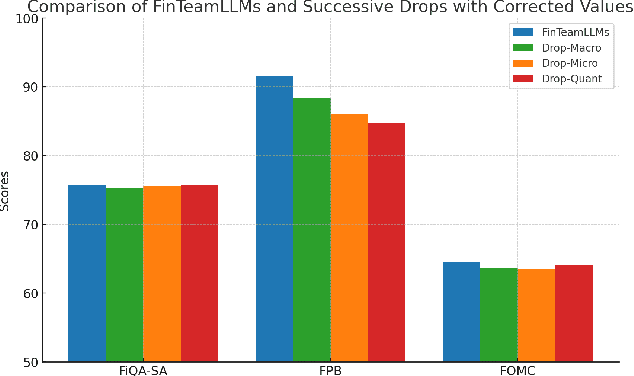
Abstract:Large Language Models (LLMs), such as ChatGPT, Phi3 and Llama-3, are leading a significant leap in AI, as they can generalize knowledge from their training to new tasks without fine-tuning. However, their application in the financial domain remains relatively limited. The financial field is inherently complex, requiring a deep understanding across various perspectives, from macro, micro economic trend to quantitative analysis. Motivated by this complexity, a mixture of expert LLMs tailored to specific financial domains could offer a more comprehensive understanding for intricate financial tasks. In this paper, we present the FinTeamExperts, a role-specialized LLM framework structured as a Mixture of Experts (MOEs) for financial analysis. The framework simulates a collaborative team setting by training each model to specialize in distinct roles: Macro Analysts, Micro analysts, and Quantitative Analysts. This role-specific specialization enhances the model's ability to integrate their domain-specific expertise. We achieve this by training three 8-billion parameter models on different corpus, each dedicated to excelling in specific finance-related roles. We then instruct-tune FinTeamExperts on downstream tasks to align with practical financial tasks. The experimental results show that FinTeamExperts outperform all models of the same size and larger on three out of four datasets. On the fourth dataset, which presents a more complex task, FinTeamExperts still surpass all models of the same size. This highlights the success of our role-based specialization approach and the continued training approach for FinTeamExperts.
Latent Space Score-based Diffusion Model for Probabilistic Multivariate Time Series Imputation
Sep 13, 2024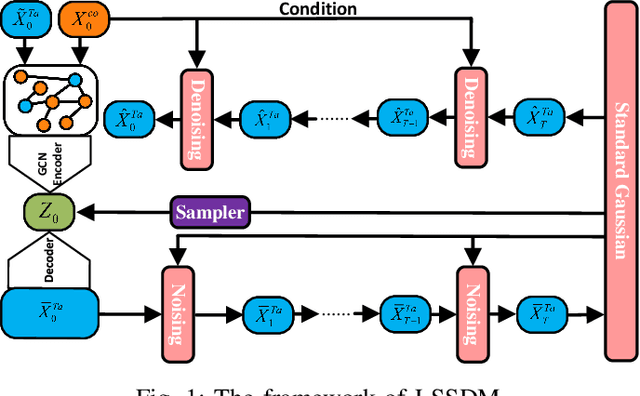
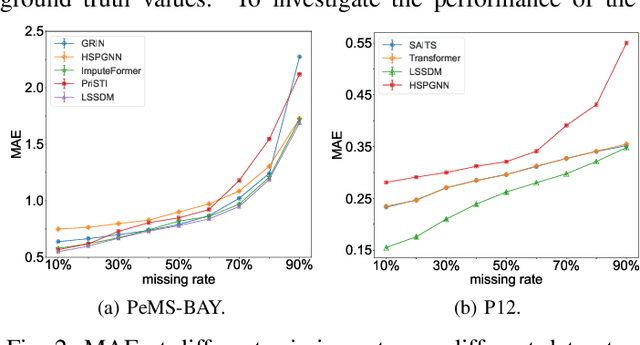
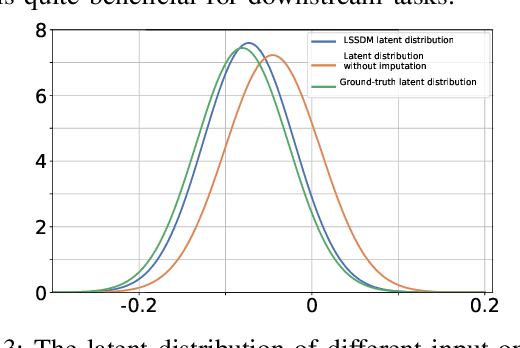
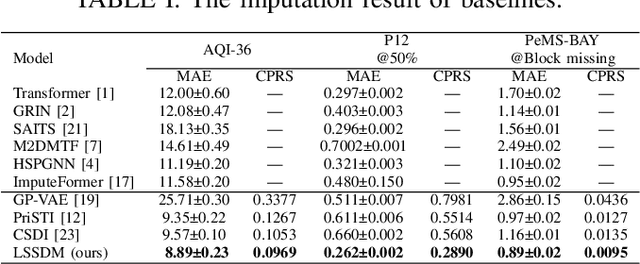
Abstract:Accurate imputation is essential for the reliability and success of downstream tasks. Recently, diffusion models have attracted great attention in this field. However, these models neglect the latent distribution in a lower-dimensional space derived from the observed data, which limits the generative capacity of the diffusion model. Additionally, dealing with the original missing data without labels becomes particularly problematic. To address these issues, we propose the Latent Space Score-Based Diffusion Model (LSSDM) for probabilistic multivariate time series imputation. Observed values are projected onto low-dimensional latent space and coarse values of the missing data are reconstructed without knowing their ground truth values by this unsupervised learning approach. Finally, the reconstructed values are fed into a conditional diffusion model to obtain the precise imputed values of the time series. In this way, LSSDM not only possesses the power to identify the latent distribution but also seamlessly integrates the diffusion model to obtain the high-fidelity imputed values and assess the uncertainty of the dataset. Experimental results demonstrate that LSSDM achieves superior imputation performance while also providing a better explanation and uncertainty analysis of the imputation mechanism. The website of the code is \textit{https://github.com/gorgen2020/LSSDM\_imputation}.
An Empirical Study on Information Extraction using Large Language Models
Sep 04, 2024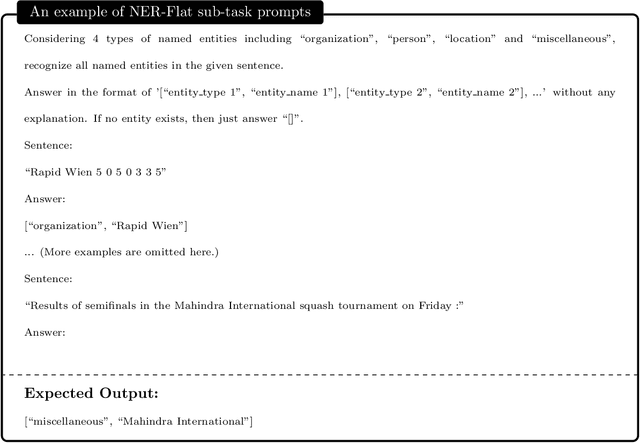
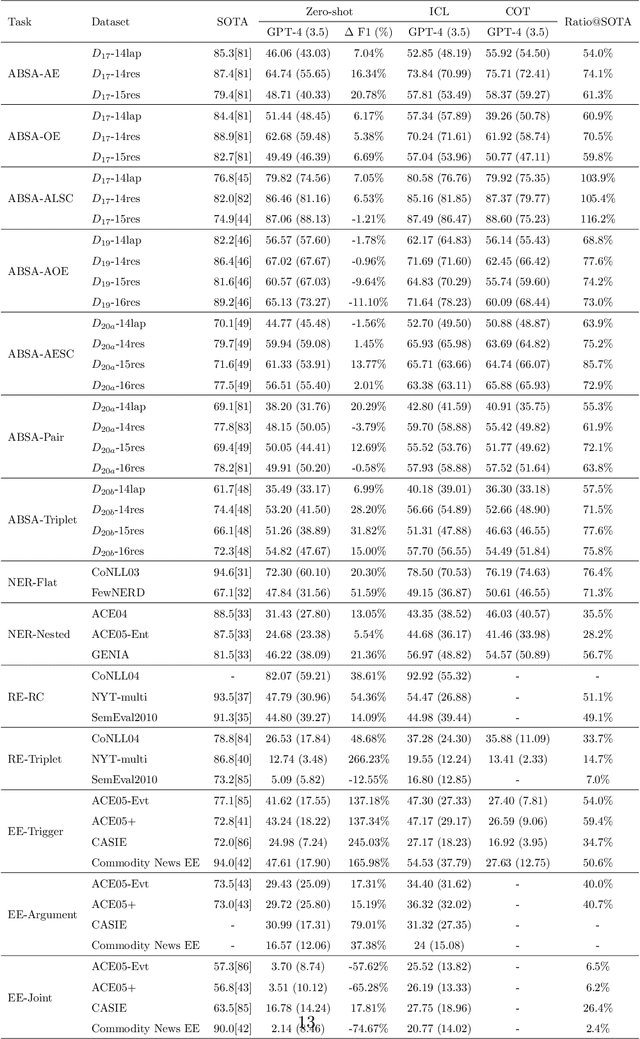
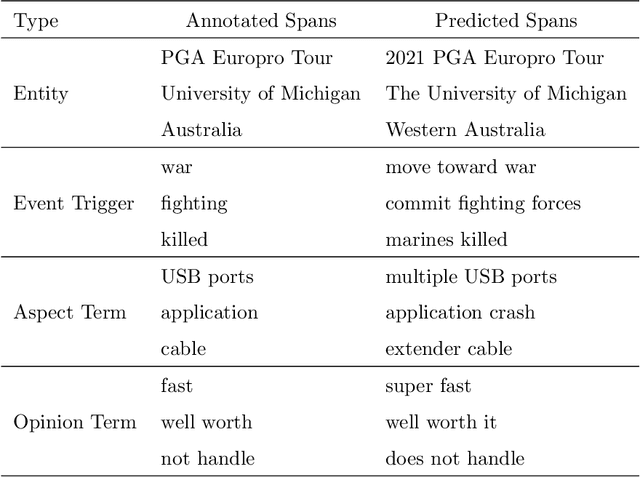
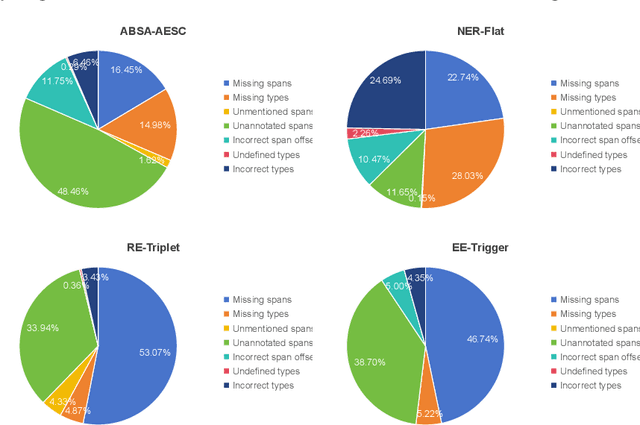
Abstract:Human-like large language models (LLMs), especially the most powerful and popular ones in OpenAI's GPT family, have proven to be very helpful for many natural language processing (NLP) related tasks. Therefore, various attempts have been made to apply LLMs to information extraction (IE), which is a fundamental NLP task that involves extracting information from unstructured plain text. To demonstrate the latest representative progress in LLMs' information extraction ability, we assess the information extraction ability of GPT-4 (the latest version of GPT at the time of writing this paper) from four perspectives: Performance, Evaluation Criteria, Robustness, and Error Types. Our results suggest a visible performance gap between GPT-4 and state-of-the-art (SOTA) IE methods. To alleviate this problem, considering the LLMs' human-like characteristics, we propose and analyze the effects of a series of simple prompt-based methods, which can be generalized to other LLMs and NLP tasks. Rich experiments show our methods' effectiveness and some of their remaining issues in improving GPT-4's information extraction ability.
SarcasmBench: Towards Evaluating Large Language Models on Sarcasm Understanding
Aug 24, 2024



Abstract:In the era of large language models (LLMs), the task of ``System I''~-~the fast, unconscious, and intuitive tasks, e.g., sentiment analysis, text classification, etc., have been argued to be successfully solved. However, sarcasm, as a subtle linguistic phenomenon, often employs rhetorical devices like hyperbole and figuration to convey true sentiments and intentions, involving a higher level of abstraction than sentiment analysis. There is growing concern that the argument about LLMs' success may not be fully tenable when considering sarcasm understanding. To address this question, we select eleven SOTA LLMs and eight SOTA pre-trained language models (PLMs) and present comprehensive evaluations on six widely used benchmark datasets through different prompting approaches, i.e., zero-shot input/output (IO) prompting, few-shot IO prompting, chain of thought (CoT) prompting. Our results highlight three key findings: (1) current LLMs underperform supervised PLMs based sarcasm detection baselines across six sarcasm benchmarks. This suggests that significant efforts are still required to improve LLMs' understanding of human sarcasm. (2) GPT-4 consistently and significantly outperforms other LLMs across various prompting methods, with an average improvement of 14.0\%$\uparrow$. Claude 3 and ChatGPT demonstrate the next best performance after GPT-4. (3) Few-shot IO prompting method outperforms the other two methods: zero-shot IO and few-shot CoT. The reason is that sarcasm detection, being a holistic, intuitive, and non-rational cognitive process, is argued not to adhere to step-by-step logical reasoning, making CoT less effective in understanding sarcasm compared to its effectiveness in mathematical reasoning tasks.
 Add to Chrome
Add to Chrome Add to Firefox
Add to Firefox Add to Edge
Add to Edge